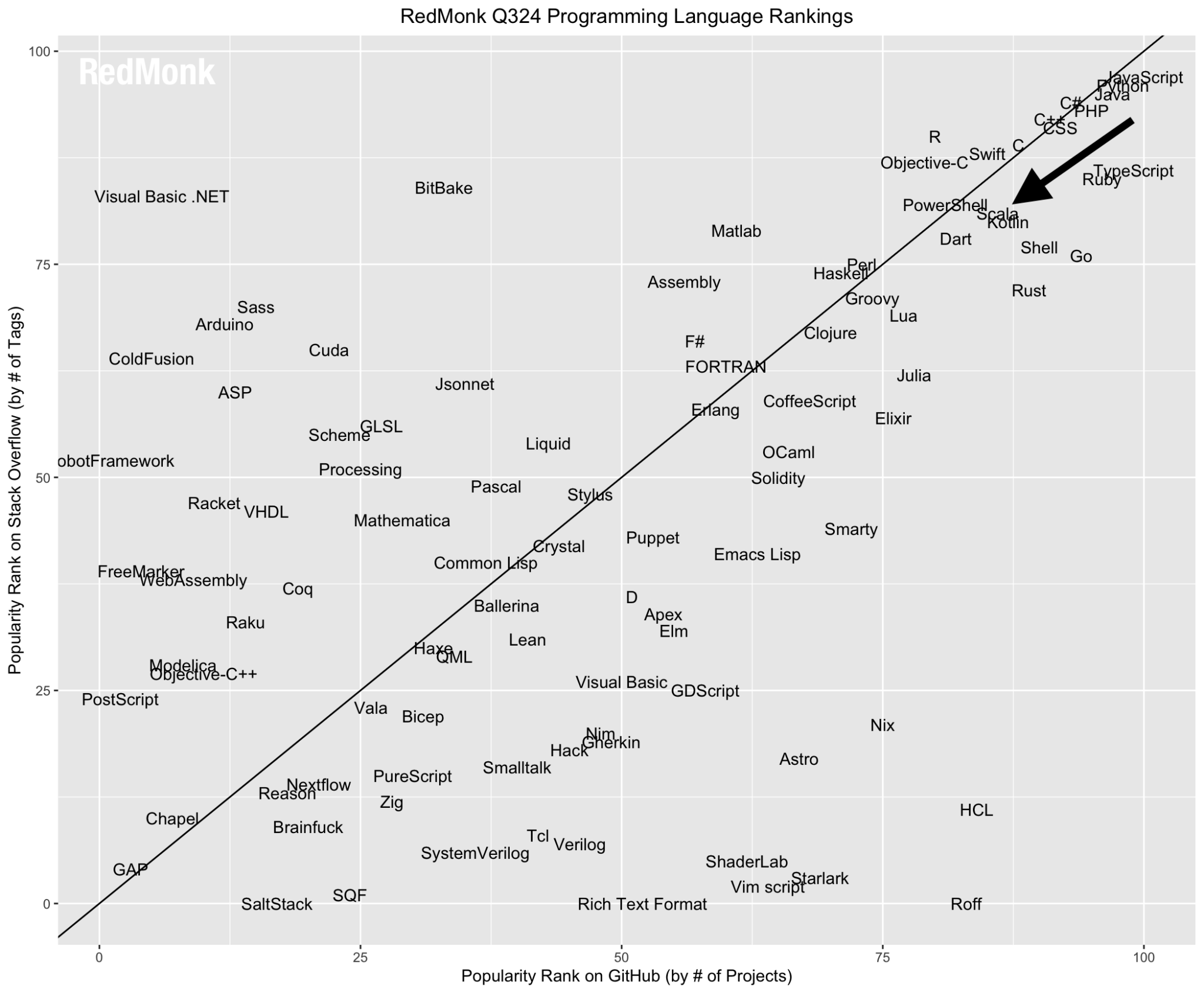About Scala¶
“Scala is an object-functional programming and scripting language for general software applications, statically typed, designed to concisely express solutions in an elegant, type-safe and lightweight (low ceremonial) manner. Scala has full support for functional programming (including currying, pattern matching, algebraic data types, lazy evaluation, tail recursion, immutability, etc.). It cleans up what are often considered poor design decisions in Java (such as type erasure, checked exceptions, the non-unified type system) and adds a number of other features designed to allow cleaner, more concise and more expressive code to be written.” [ScalaWikipedia]
Scala has no connection to La Scala or Teatro alla Scala (the world renowned opera house in Milan), but we (especially Dr. Thiruvathukal) love the name because it addresses the traditions of programming languages and scalable computing, while La Scala is the title of one of his favorite jazz piano albums by Keith Jarrett, who often names his concerts by the venues where he performs. [LaScalaConcert]
We’d like to think that the Scala language represents the design ideal of being “small and beautiful” but also great for computer science and data science and practical problem solving. We hope you agree!

Source is Wikimedia Commons [LaScala]
Why Scala?¶
Scala is an object-oriented, functional, and concurrent general-purpose programming language. As the language behind Apache Spark, a widely used data science framework, Scala has proven to be a suitable choice for data science. Scala can also be an effective choice for learning computer science.
But what about Python, R, or Julia?
Unlike those dynamically typed languages – which we use in our research, too – Scala is statically typed, which means that type errors are caught at compile time rather than at runtime. This typically helps with both reliability and performance. Because Scala’s type system is mostly implicit, we can use Scala in a way that is similarly concise and expressive as Python, but with the above-mentioned benefits of static typing.
Scala thereby addresses the P3 concerns of performance, portability, and productivity in high-performance computing. But even if you’re not developing HPC applications, Scala is useful for developing software tools and for data-intensive computing. Because it has the conciseness of Python and a rich ecosystem from the Java and Scala communities, it is relatively easy to incorporate in your work.
Scala appeared on the programming language landscape in 2004 and has had a stable presence among the top 20 languages for over a decade.
As we are polyglot programmers, we also advocate for Scala as a way of thinking. And who knows? It may even help you to discover the functional language capabilities in your favorite language, whether type-safe or not.
RedMonk Language Rankings¶

It was ranked similarly (13th) ten years earlier.
Based on the RedMonk programming language ranking, which combines data from GitHub and StackOverflow, Scala is ranked 14th in 2024, along with shell scripting languages and Kotlin.
Rank |
Language |
Type |
|---|---|---|
1 |
JavaScript |
Web |
2 |
Python |
General |
3 |
Java |
General |
4 |
PHP |
Web |
5 |
C# |
General |
6 |
TypeScript |
Web |
7 |
CSS |
Web |
7 |
C++ |
General |
9 |
Ruby |
General |
10 |
C |
General |
11 |
Swift |
General |
12 |
Go |
General |
12 |
R |
General |
14 |
Shell |
Shell Scripting |
14 |
Kotlin |
General |
14 |
Scala |
General |
17 |
Objective-C |
General |
18 |
PowerShell |
Shell Scripting |
19 |
Rust |
General |
19 |
Dart |
Mobile |
Tease - Filtered by Aim of Language¶
This Scala script shows how to filter the general-purpose languages, excluding those primarily focused on web, mobile, and shell programming.
Note
The comment lines you see here are not GPT comments. The first demonstrates that Scala can now be fully utilized for Unix scripting using the shebang or hash bang syntax. The second specifies the Scala compiler backend to use for executing the script.
#!/usr/bin/env scala
//> using scala "3.4.2"
case class Language(originalRank: Int, name: String, category: String)
val languageData =
"""1, JavaScript, Web
|2, Python, General
|3, Java, General
|4, PHP, Web
|5, C#, General
|6, TypeScript, Web
|7, CSS, Web
|7, C++, General
|9, Ruby, General
|10, C, General
|11, Swift, General
|12, Go, General
|12, R, General
|14, Shell, Shell Scripting
|14, Kotlin, General
|14, Scala, General
|17, Objective-C, General
|18, PowerShell, Shell Scripting
|19, Rust, General
|19, Dart, Mobile""".stripMargin
val allLanguages: Iterator[Language] = languageData.linesIterator
.map { line =>
val parts = line.split(",").map(text => text.trim)
val rank = parts(0).toInt
val name = parts(1)
val category = parts(2)
Language(rank, name, category)
}
val generalPurposeLanguages: Iterator[(Language, Int)] = allLanguages
.filter { language =>
language.category.equalsIgnoreCase("general")
}
.zipWithIndex
println("General-purpose languages:")
println(f"${"GeneralRank"}%-12s ${"OriginalRank"}%-13s ${"Language"}")
println("-" * 40)
for ((language, generalIndex) <- generalPurposeLanguages) {
val generalRank = generalIndex + 1
val originalRank = language.originalRank
val name = language.name
println(f"#$generalRank%-11d #$originalRank%-12d $name")
}
$ ./language-filter.sc
Compiling project (Scala 3.4.2, JVM (21))
Compiled project (Scala 3.4.2, JVM (21))
General-purpose languages:
GenRank LangRank Language
--------------------------------
#1 #2 Python
#2 #3 Java
#3 #5 C#
#4 #7 C++
#5 #9 Ruby
#6 #10 C
#7 #11 Swift
#8 #12 Go
#9 #12 R
#10 #14 Kotlin
#11 #14 Scala
#12 #17 Objective-C
#13 #19 Rust
The first version shown was aimed at clarity. As you write more Scala, you will come to learn that type inferencing allows for even greater conciseness.
#!/usr/bin/env scala
//> using scala "3.4.2"
case class Language(originalRank: Int, name: String, category: String)
val data =
"""1, JavaScript, Web
|2, Python, General
|3, Java, General
|4, PHP, Web
|5, C#, General
|6, TypeScript, Web
|7, CSS, Web
|7, C++, General
|9, Ruby, General
|10, C, General
|11, Swift, General
|12, Go, General
|12, R, General
|14, Shell, Shell Scripting
|14, Kotlin, General
|14, Scala, General
|17, Objective-C, General
|18, PowerShell, Shell Scripting
|19, Rust, General
|19, Dart, Mobile""".stripMargin
val generalLanguages = data.linesIterator
.map { line =>
val parts = line.split(",").map(_.trim)
Language(parts(0).toInt, parts(1), parts(2))
}
.filter { language => language.category.equalsIgnoreCase("general") }
.zipWithIndex
println("General-purpose languages:")
println(f"${"GeneralRank"}%-12s ${"OriginalRank"}%-13s ${"Language"}")
println("-" * 40)
for ((language, index) <- generalLanguages) {
println(f"#${index + 1}%-11d #${language.originalRank}%-12d ${language.name}")
}
Technology Radar¶
Thoughtworks maintains a resource known as the Technology Radar [TWTechRadar], which uses four classifications for items in various categories, including languages and frameworks:
Adopt
Trial
Assess
Hold
Scala has been listed under Adopt since October 2012.
Language Complexity¶
See our 2013 ACM SIGCSE Scala Workshop presentation for now, http://goo.gl/Q68fA.
References¶
Redmonk Programming Language Rankings, http://redmonk.com/sogrady/2014/01/22/language-rankings-1-14/
Scala Programming Language, Wikipedia, http://en.wikipedia.org/wiki/Scala_(programming_language)
La Scala, Wikimedia Commons, http://en.wikipedia.org/wiki/File:Milano-scalanotte_e.jpg
Keith Jarrett, http://en.wikipedia.org/wiki/La_Scala_(album)
Thoughtworks Technology Radar, http://www.thoughtworks.com/radar/